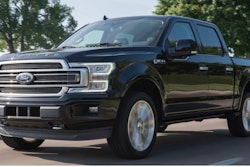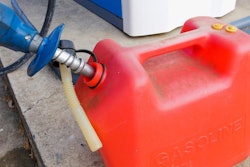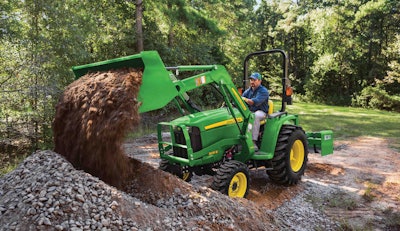 Photo: John Deere
Photo: John DeereAs a landscape contractor, you want to get the most bang for your buck, so if you’re looking for a machine to add to your fleet to boost your productivity, compact tractors can be a good option, depending on the nature of your work.
“Due to the variety of work a compact tractor can tackle through different attachments and implements, it should truly be one of the first additions to a landscaper’s fleet,” says Ron Morgan, Northeast territory manager, for Kioti. “That versatility makes it an excellent return on your investment compared to other products. As a landscaping business, you don’t always know what types of projects you’ll have the most demand for, making compact tractors the perfect starter tool to grow your business.”
If you’re just starting out, a compact tractor can save considerable time compared to manual labor.
“A small tractor’s main advantage is its ease of use and versatility,” says Kelcey Cockrell, a Kubota product manager for the BX, B, L, & MX Series. “The size, maneuverability and implement compatibility allow compact tractors to tackle all kinds of tasks all year-round. With front, rear and mid-mount implement options, landscapers are often amazed at how much time and effort can be saved by investing in a tractor.”
While compact tractors are ideal for landscapers who are completing a variety of jobs, Ray Gherardini, product marketing manager for John Deere advises renting one for occasional jobs.
“However, if the machine is going to be used for many hours, it might be time to purchase a unit,” Gherardini says. “When purchasing a new machine, owners should speak with their dealer about implements they know they will want and frequently use. Many people do not realize that implements can often be wrapped into a financing package, allowing the owner to pay off the implement along with their machine.”
Best jobs for compact tractors
Thanks to the wide variety of attachments compact tractors can use, this machine is suited for just about any task with the right implement.
“Through various attachments, compact tractors allow you to explore several different types of landscaping tasks,” Morgan says. “From land clearing and brush cutting with a rotary cutter to arm-mounted mowers for embankment mowing and grooming, the jobs and capabilities of a compact tractor are endless.”
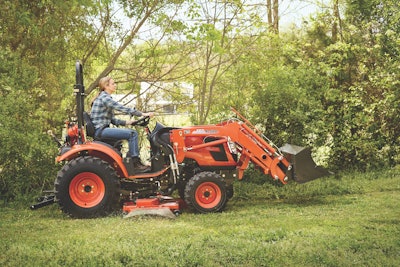 Photo: Kioti
Photo: KiotiThe most popular attachments to use on compact tractors include loaders, rotary tillers, backhoes and mowers.
“From moving dirt to carrying heavy materials like gravel, loaders offer the benefits of a specialized machine like a skid steer without the added cost of owning one,” Gherardini says. “Additionally, loaders can be transformed with a variety of attachments, like grapple buckets or light materials buckets, allowing operators to perform tasks like picking up tree stumps and branches or moving large amounts of light material such as tree bark or mulch.”
Gherardini says rotary tillers can be used everywhere from small flowerbeds to large lots and fields, while backhoes are suited for installing underground utilities or moving large amounts of soil.
Mower attachments can be either mid-mount or rear-mount models. Mid-mount mowers are suited for mowing turf, while rear-mount finish mowers are ideal for mowing large, open areas.
When trying to decide if you should use a compact tractor over a skid steer or a compact track loader, consider your specific needs and the jobs you handle the most.
“They (compact tractors) offer great flexibility in what you do and how you do it,” Cockrell says. “A skid steer loader is often used in applications where the jobs tend to be less dynamic, such as material loading. Skid steers do a good job, but they are not as versatile or as easy to use, especially for a new owner. Not to mention that both the skid steer and the implements for the skid steers tend to be more expensive when compared to a compact tractor.”
Gherardini says some of the ways to determine which machine to use is to consider the price, the intended use and the size of the property.
“For example, if you want to mow with your machine in addition to other projects, a compact utility tractor is the best option, as you can add a mower to the machine,” Gherardini says. “A dealer can help sort through your needs to determine the right machine.”
Morgan adds that compact tractors have a forward-reaching ability that lets you reach over trees, embankments and other barriers, while the compact tractor’s weight capacity it typically lighter compared to how much they can lift.
“This makes them an attractive draw in landscaping businesses,” Morgan says. “Depending on a business’ fleet, compact tractors also add the ability to tow and transport other equipment in their fleet to, from and within different job sites.”
Pros and cons of compact track loaders
When weighing the benefits and drawbacks of compact tractors, the most obvious pro is the machine’s versatility.
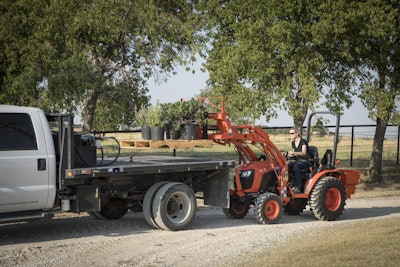 Photo: Kubota
Photo: Kubota“Compact utility tractors allow operators to tackle a variety of jobs without investing in multiple pieces of equipment,” Gherardini says. “Through the simple addition of implements – hundreds of which are available for purchase – a compact utility tractor can be used for everything from digging and trenching to grading and moving materials. Additionally, compact tractors can be equipped with cabs and snow removal implements to arm these machines for winter weather.”
Training is also simplified, as your crews can learn how to do a number of jobs with one machine. Aside from the cost efficiency that comes from not having to purchase multiple machines, Morgan adds that maintenance is also easier on compact tractors.
“For example, if you have a technician on your job site, compact tractors offer ease of access to their hydraulic filter,” Morgan says. “This makes changing hydraulic fluid, engine oil and fuel filters, as well as performing other routine maintenance tasks, so much easier.”
Visibility is also improved thanks to the upper position compact tractors offer.
As for the cons of compact tractors, the main issue is the size of the machine.
“These machines are not ideal for smaller properties or spaces with tight access points which would not allow the machine to fit through,” Gherardini says. “It is important to evaluate the types of properties you maintain to ensure this machine is right for your business.”
Specs to consider
If you’ve decided that you would use a compact tractor enough to justify purchasing one, some of the questions to ask include what jobs you plan to use it for and what are the sizes of the job sites?
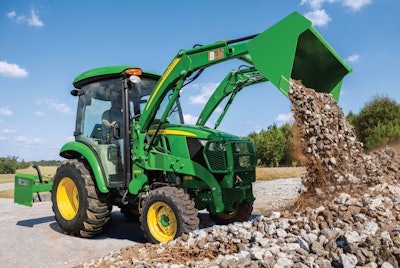 Photo: John Deere
Photo: John DeereGherardini says determining the type of work you’ll be doing and the terrain you’ll be working on will help you select the right compact tractor for the job. An important spec to consider is the lift capacity.
“If a landscaper plans to do a lot of lifting and loading, he or she may want to consider a larger lifting capacity like Kioti’s DK10SE Series, which allows up to 2,600 lbs.,” Morgan says. “On the other hand, Kioti’s CK10 Series, with a lifting capacity of 1,200 to 1,600 lbs., may be the perfect fit for more routine landscaping jobs.”
The nature of the job and jobsite will also determine what are the best tires for the tractor.
“If you’re working on established lawns and need minimum turf damage, then you’ll want turf tires,” Cockrell says. “If it’s more heavy-duty or turf damage isn’t an issue, then ag or industrial tires are a great fit. Customers should remember that their local dealer is one of the best resources for choosing the right equipment. They know the local area better than anyone and will be happy to help any customer select the right equipment for their task.”


